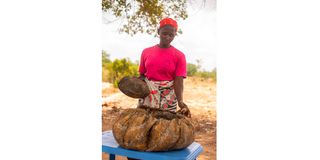Restoring the ecosystem one fireless cooker at a time

Agnes Kashindo, a resident of Kilifi, showcases an improvised fireless cooker she uses in pursuit of environmental conservation.
What you need to know:
- WHO classifies firewood and charcoal as polluters.
- Clean cooking fuels that are safe for the environment and household use include solar power, cooking gas (liquefied petroleum gas), biogas, ethanol and natural gas.
Agnes Kashindo has a new morning routine. After breakfast, she starts preparing for her family’s lunch and, immediately after, supper. She must start making food early because the meals take longer than before. It wasn’t always like this.
For decades, the mother of four had a profound reliance on firewood to cook, a tradition passed down to her. Proximity played its role as the expanse of Arabuko Sokoke Forest, a UNESCO biosphere reserve and the largest coastal forest in East Africa, stood as a ready supplier, mere steps away from her home.
She turned to the cashew nut trees encircling her home on days she couldn't venture into the forest. The lingering stumps are a silent testament to the toll of degradation. “We were perturbed by the steady decline of the forest, which is home to more than 600 varieties of trees and dozens of animal species and insects. With funding from I &M Foundation and Kenya Community Development Foundation (KCDF), we started training communities neighbouring the forest on matters of environmental conservation. To help them reduce dependency on firewood and save trees, we trained and offered some households with materials to make fireless cookers,” says Stanley Baya, the community conservation manager at A Rocha, a faith-based organisation that works in environmental conservation.
“I start off by cooking on the open fire and after the first boil, I transfer the sufuria into the fireless cooker and cover it. I made the cooker using a cotton fabric material that I tailored and then stuffed with unused clothing. The cooker is well-padded for insulation and helps to keep the food warm. With this, I can tend to my farm or attend to other duties as the food cooks,” muses Agnes, 36.
After she started using the fireless cooker, Agnes reflects that a bundle of firewood, which would last for a day or two, can now last for at least seven days.
“While primarily using firewood for cooking, I used to experience eye irritation, watery eyes and had frequent coughs, but I am better now. My children, who also help at the kitchen, share the same feelings,” she offers.
Margaret Kahindi, a resident of Funga Moyo village in Kilifi County, is another user of a fireless cooker. She confesses that at a time like this a year ago, she did not think about the negative impact of cutting down trees for firewood or charcoal on the environment.
“All my life firewood is the only form of fuel that I have been using and what I saw being used at our home while growing up. Even now, villagers come to my home in awe of this cooker. While some get fascinated and ask that I train them on how to make one, some remain convinced that food cooked by using firewood only is more flavourful. I am aware of other better and faster options like cooking gas, but I cannot afford both the upfront costs and other associated expenses I use what is readily available,” she reflects.
To prepare rice, a staple food in her home, the mother of six cooks in the open fire for about five minutes, then transfers to the fireless cooker for another 30 minutes. “The best thing is that it does not burn food, and no maintenance costs are associated.” The fireless cookers, an improvised fashion of conventional slow cookers, are designed to use less firewood while reducing emissions of harmful pollutants.
According to the World Health Organization (WHO), around 2.4 billion people still cook using solid fuels (such as wood, crop waste, charcoal, coal and dung) and kerosene in open fires and inefficient stoves. Most of these people are poor and live in low- and middle-income countries.
WHO classifies firewood and charcoal as polluters. Clean cooking fuels that are safe for the environment and household use include solar power, cooking gas (liquefied petroleum gas), biogas, ethanol, and natural gas. In June, UN Secretary-General Antonio Guterres said that countries must phase out fossil fuels and not just emissions, as stated by the United Arab Emirates, which will host climate change negotiators (COP28) later in the year.
However, access to clean cooking fuels remains beyond reach for many families. As a result, many households, unable to afford alternatives, resort to using firewood as their primary source of cooking. According to a recently released Kenya Demographic and Health Survey (KDHS), only five per cent of those in rural areas rely on clean fuels and technologies for cooking and space heating.
The use of clean fuels is directly linked to increased wealth. Mandera County, for instance, has only one percent of households relying on clean energy and technologies. The national average is 21 per cent. As the transition to sustainable and just energy sources gains momentum, Mr Baya observes that many quarters risk being left behind in the wake of transformation and that the alternatives, although they play an integral role in reducing environmental degradation, are not as efficient as most clean fuels solutions.
“Transitioning to clean energy might be a dream for families that are already grappling with economic hardships. The alternatives we give to these communities also have limitations. Still, through awareness and education programmes on environmental conservations, families have options that they can adopt in pursuit of a just energy future and with an increased income,” says Mr Baya.





